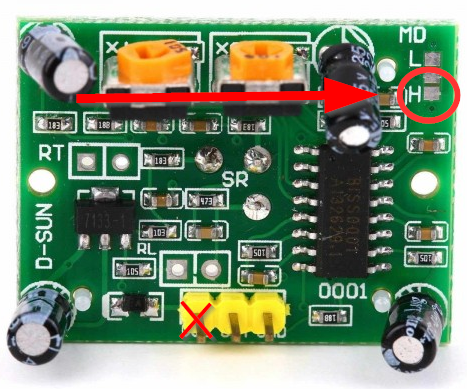Rechargeable Lithium Ion Sensor Custom PCB
-
Hi!
Since a bunch of people already made a custom MySensors PCB, I decided to get used to Eagle and create my own board to fit my needs
The key difference compared to other custom PCBs is the Lithium Ion Charging Circuit with micro USB connector. So you can just grab a flat smartphone battery with 1000 mAh or more and stick it under the PCB! This way you never have to worry about changing batteries, and even if your configuration consumes a lot of power, you can quickly recharge your sensor through the micro USB connector of the Li-Ion Charging Module.The board is currently only designed to work with the Arduino Pro Mini 3.3V version.
Version 0.1 is tested, I received the PCBs on 01/26/2016. Everything works fine (good radio range), there is only one little problem with the connection of the battery (but it is fixable; see post 52 in this thread for a fix)
So here are the specifications and features of my board:
- designed for cheap 3.3V Arduino Pro mini clones from china, for example this one
- 5x5cm
- uses jumper bridge to simply connect and disconnect the battery
- easy attaching of motion sensor (use 3.3V mod), DHT22 for Temp and Humidity Measurement and one switch (for example button- or reedswitch)
- small prototyping area on the backside
- uses TP4056 Li-Ion single cell Micro USB 1A charging circuit with battery protection (disconnects the power automatically if voltage drops below 2.4V
------> make sure you get the NEW version of the TP4056 with battery protection circuit!
remember to charge your li-ion 1-cell rechargeable battery with maximum 1C, so if you want to use a battery below 1000 mAh you need to make modifications to the module or the charging current will be way to high, which could result in an explosion (worst case) - I suggest to use the board with a smartphone battery, as they usually are very small and flat and have a high capacity for small money. I will use the galaxy s4 battery because it fits nearly perfect under the board and has 2600 mAh.
- Now with additional relay, properly connected using 2N2222A transistor, flyback diode, 1kΩ resistor and terminal block for easy attaching of "switchable things" to the relay
Schematics (Rev 1.0)
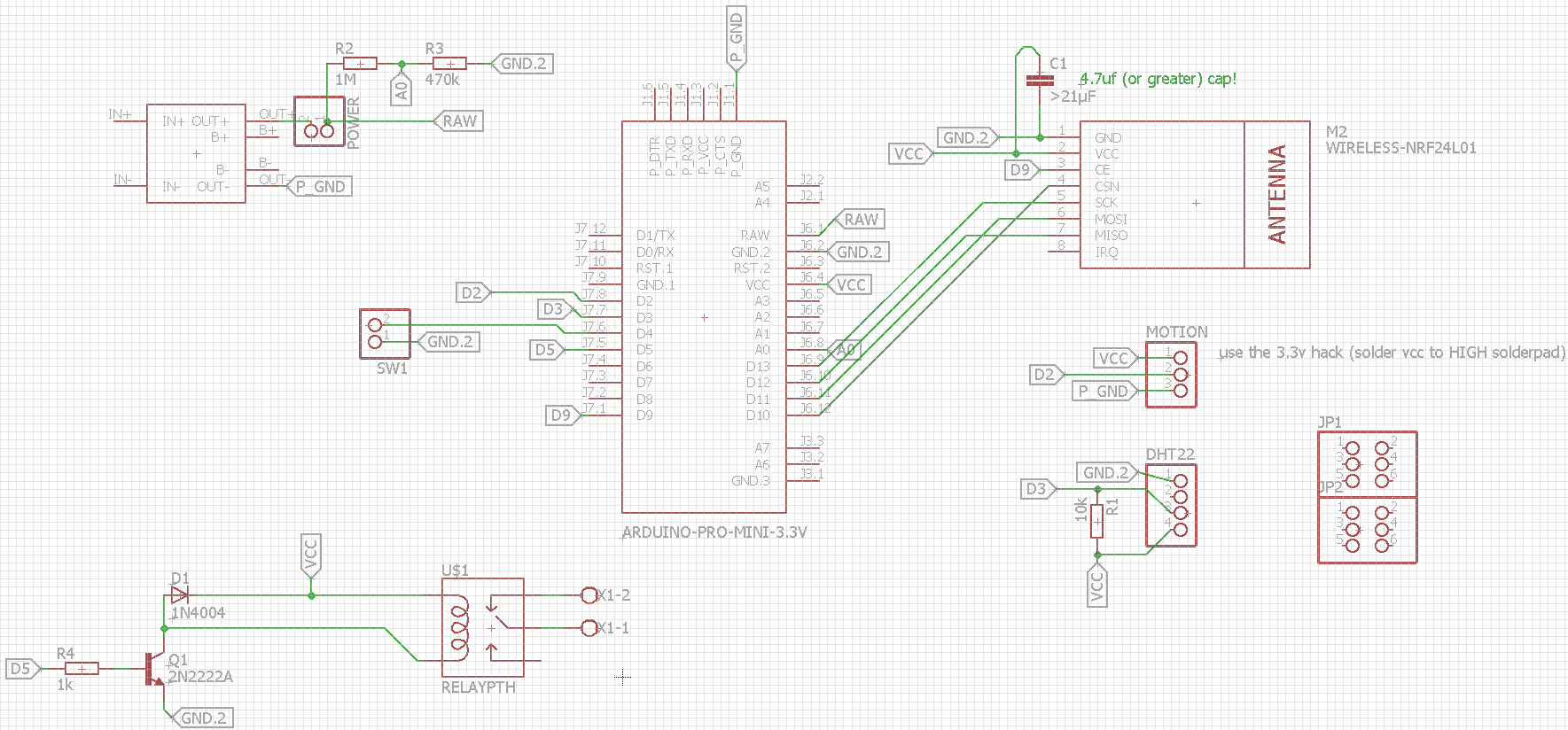
Board view (Rev 1.0)
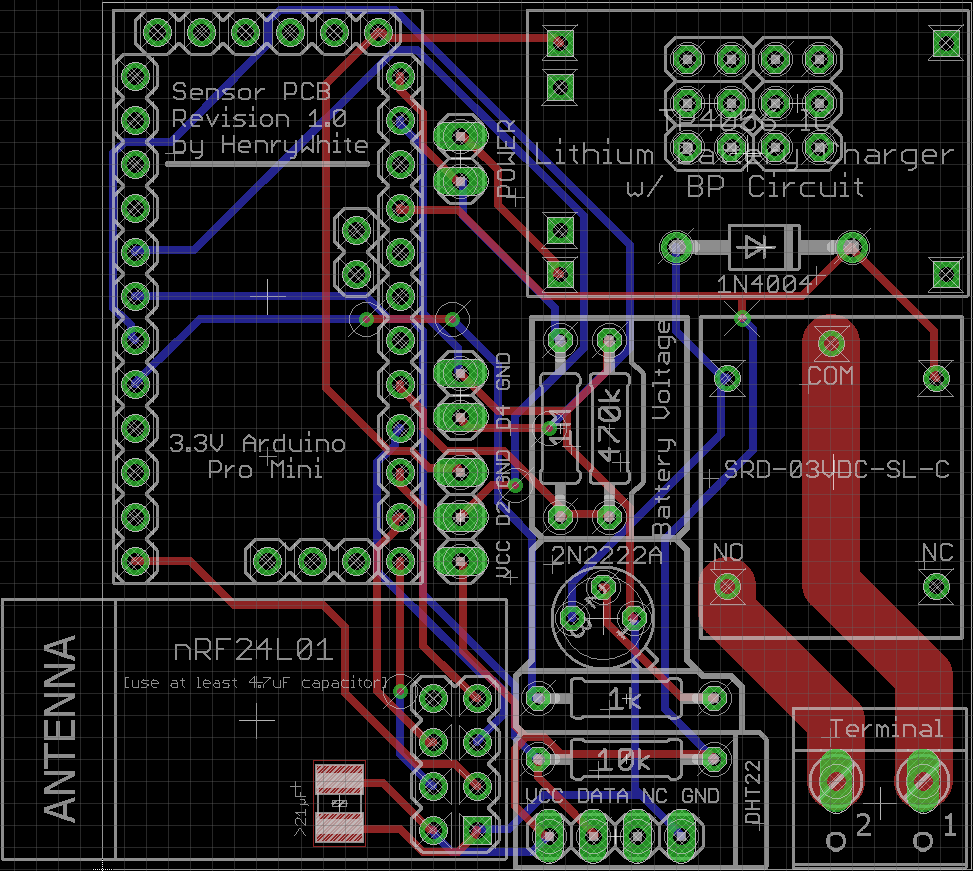
3D board view (Rev 1.0)
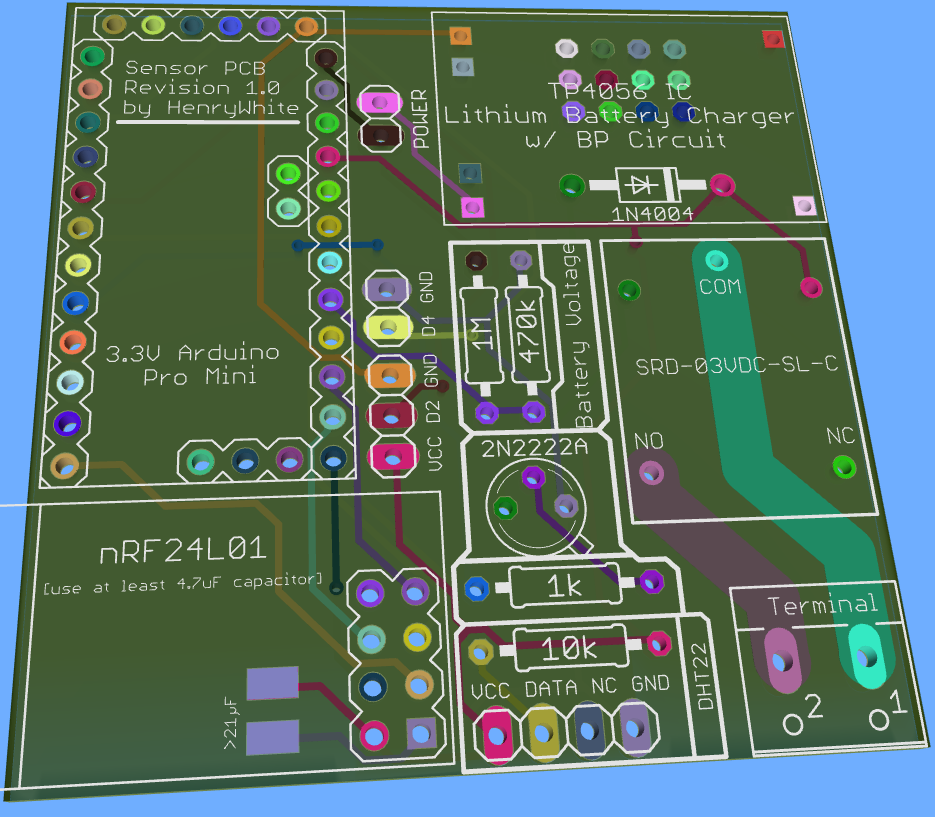
Build files
Rev 1.0:
- Now with additional relay, properly connected using 2N2222A transistor, flyback diode, 1kΩ resistor and terminal block for easy attaching of "switchable things" to the relay
- proper alignment of DHT22
Eagle files: 0_1453762986505_Sensorboard_v1.0.zip
Gerber files: 0_1453763061782_Sensorboard_v1.0_Gerber.zipRev 0.3: swapped footprints of DHT22 and prototyping area to prevent false temp measurements when charging the battery; connected TP4056 OUT to arduino's RAW instead of VCC_IN (so the internal voltage regulator is used)
sensorboard_v0.3.sch
sensorboard_v0.3.brdRev 0.2: added footprint for 47uF SMD capacitor standard 1210 (i guess many other smd caps will fit too)
sensorboard_v0.2.sch
sensorboard_v0.2.brdRev. 0.1
untitled.sch untitled.brd
-
Looks really good.
Which 'flavour' of Pro Mini are you going with? I have ones with different pinouts. Also, I2C support would be good - for BMP180, SHT21, etc. (although can use prototyping area).
-
@MikeF said:
Which 'flavour' of Pro Mini are you going with?.
Whoops, sorry. Forgot to point that out. It is the pinout version most of the chinese clones use, for example: http://www.aliexpress.com/item/1pcs-lot-Pro-Mini-328-Mini-3-3V-8M-ATMEGA328-ATMEGA328P-AU-3-3V-8MHz-for/32313595044.html
-
Thanks for the clarification.
I've been using these:
-
If you can provide a valid eagle footprint library for these kind of pro mini clone I could make a version for that clone too

-
Great work!
This might be a stupid question but why haven't you added a slot for soldering the capacitor for the nrf?
-
@mfalkvidd said:
Great work!
This might be a stupid question but why haven't you added a slot for soldering the capacitor for the nrf?At first I thought about it, but then I realized you can just solder the capacitor directly onto the nRF which will make everything only a few mm higher, so I don't have to waste space on the board itself.
Best thing would be to use a SMD capacitor to solder onto the nRF VCC and GND pins - it won't take more space than without the SMD cap.Is there any reason the cap should be placed on the board instead of the nRF itself? If this is the case I could add footprints for a SMD cap under the nRF

-
@HenryWhite said:
Is there any reason the cap should be placed on the board instead of the nRF itself? If this is the case I could add footprints for a SMD cap under the nRF

Just to make soldering easier. I soldered 15 caps to 15 nRFs today so I'm a bit fed-up, that's all

-
@mfalkvidd said:
@HenryWhite said:
Is there any reason the cap should be placed on the board instead of the nRF itself? If this is the case I could add footprints for a SMD cap under the nRF

Just to make soldering easier. I soldered 15 caps to 15 nRFs today so I'm a bit fed-up, that's all

I think I will add a footprint for a SMD cap under the nRF, there's plenty of unused space anyway

-
Updated to Rev 0.2:
- SMD capacitor footprint added (see first post)
- made sure no route is under the nRF antenna to prevent interference
-
@HenryWhite Just a suggestion.. you could break out the SDA/ SCL pins (A4/A5) to be able to use other Temp/Hum sensors like SHT21/ SI7021 boards. These work reliable, at lower voltages and are in the same price range as the DHT22 (but lack the plastic housing..)
-
I think, on Rev 0.2 the download link for the board is wrong, it is the same as for Rev 0.1.
I think it is also imported that the antenna will not be covered by the shield pcb (see http://forum.mysensors.org/topic/1109/sensor-shield-for-arduino-pro-mini-3-3v-with-boost-up-regulator)
-
@AWI: I will think about it
@Heizelmann said:
I think, on Rev 0.2 the download link for the board is wrong, it is the same as for Rev 0.1.
I think it is also imported that the antenna will not be covered by the shield pcb (see http://forum.mysensors.org/topic/1109/sensor-shield-for-arduino-pro-mini-3-3v-with-boost-up-regulator)
yeah the link is the same, i will update it. Did you made measurements to compare the range of the nRF when mounted onto the board and mounted sticking out? I'm not sure but I don't think this would make any difference, as there are no routes under the antenna or even a ground fill on the board.
-
@HenryWhite said:
Did you made measurements to compare the range of the nRF when mounted onto the board and mounted sticking out?
No. With shield PCB I meant the ground fill. In your pictures I can not see if you leave this region out for filling. At least it is prophylactic.
What I tested is only this antenna modification. For me it really helps. May be this can be taken into account for the layout.
-
@Heizelmann said:
What I tested is only this antenna modification. For me it really helps. May be this can be taken into account for the layout.
I plan to use this mod too. I'm curious if the additional wire(s) has/have to be straight or if you can twist it/them. If you use a single straight wire, it should already be compatible with the layout, the wire would be above the arduino.
-
I have some thoughts about voltage.
A LiPo is 4.2 volt when it is 100% charged or when you have charged it for a few minutes, power will come from charger TP4056.
Do you use the regulator on Arduino board?
Can I use your files and modify it?
-
@flopp said:
Can I use your files and modify it?
Yes, absolutely.
But I don't think you need a voltage regulator. At least on the arduino I ordered there's already an onboard regulator which is rated for up to 12V DC input.
-
I'm thinking of building the same kind of board for protyping sensors, also powered by Li-Ion or LiPo cells as I have plenty lying around

The TP4056 board will protect the cell if voltage drops bellow 2.8v. The arduino and nrf24 module should be fine at those values. This might not be the case for all sensors...
However when charging or at 4.2V the nrf24 module will exceed its 3.6V max input power. Did you manage to get your board working ?
-
@akumar said:
The TP4056 board will protect the cell if voltage drops bellow 2.8v. The arduino and nrf24 module should be fine at those values. This might not be the case for all sensors...
That's right, but for this case (which will only happen once a year or less (depending on configuration and used lipo battery) you have the battery measurement supported through mysensors onboard, which can tell you if the voltage drops below a certain level.
Also make sure to get the new tp4056 because the old and common one does not have a battery protection circuit!
@akumar said:
However when charging or at 4.2V the nrf24 module will exceed its 3.6V max input power.
No, the nRF24 is hooked up to VCC of the arduino, which has an internal voltage regulator. So the VCC output of the arduino should always be max. 3.3V, as long as the input is below 12V.
-
If the arduino is outputing 3.3v that means that you are powering the arduino with the RAW pin, isn't it ?
If so make sure the linear voltage regulator on the arduino will be able to provide the 3.3v if battery voltage drops below 3.3v (so from 3.3v to 2.8v). I don't think they can boost the voltage from 2.8v back to 3.3v
-
@akumar said:
make sure the linear voltage regulator on the arduino will be able to provide the 3.3v if battery voltage drops below 3.3v (so from 3.3v to 2.8v).
That's not necessary - for this case you have the battery measurement circuit as mentioned in my previous post.
-
@HenryWhite said:
That's not correct. You are mixing up something. The RAW pin is for unregulated power input. With this you can bypass the internal voltage regulator. When you use the normal VCC input, the voltage will be regulated to 3.3V, if the input is (depending on arduino model) between 3.3V and 12V.
It is actually the other way around. From https://www.arduino.cc/en/Main/ArduinoBoardProMin :
If you're supplying unregulated power to the board, be sure to connect to the "RAW" pin on not VCC.
Power on RAW pin results in the regulator being in use.
Power on Vcc bypasses the regulator.
-
This post is deleted!
-
@mfalkvidd said:
Power on RAW pin results in the regulator being in use.
Power on Vcc bypasses the regulator.indeed. seems like I mixed up something there

I will update the eagle files when i have time to.
-
I did the same mistake in the beginning. not sure why it is so confusing

-
So if I sum up, powering this node with a single Lipo cell will work by connecting the Lipo to the raw pin on the arduino. This will work from 4.2v to 3.4v. This is not that good for the battery life.
Using 2*AA batteries with a boost converter seems a lot easier...
I'm almost giving up on this idea : I liked the flat form factor of the lipos and they were solar pannel friendly. Is there a way to use a voltage regulator from 4.2v to 3.4v and then switch the circuit to a boost converter from 3.3v to 2.8v ?
-
@akumar It's the same problem as with all lipos. But you have to consider that it will take a really long time until the battery hits 3.4V or less. There are even smartphone batteries with 3000+ mAh which are very small.
Also it seems to be good for battery lifetime when the voltage does not drop that much compared to using a step-up converter below 3.4V.
-
@akumar
You shall not go below 3,0v on a Lipo, it will/can get damage
-
Looking at discharge curves I can see that I should be able to squeeze 75% of the battery capacity if I charge it back when it reaches 3.3v. On a low power node this could work.
@flopp The reason I was mentionning 2.8v is because the battery protection module will kick in at this voltage. But you're right, no reason to go this far.Thanks !
-
@akumar
That battery protection is built-in on battery, but must take it with care. There as some cheap LiPo that doesn't have that feature.
I don't think the TP4056 have protection or does it?
-
Sure ! The newer ones have a battery protection chip. I've tested it and it kicks in at 2.8v.
http://www.aliexpress.com/item/Free-Shipping-10pcs-lot-1a-lithium-battery-charging-18650-with-protection-one-plate-protec-2-in/1876166772.html
-
Now I see, there are pads for battery and pads for out. Looks good
-
@flopp said:
Now I see, there are pads for battery and pads for out. Looks good
Correct. The old Tp4056 modules do not have the OUT terminals (and therefore won't fit on the pcb I designed in this thread)
@akumar said:
On a low power node this could work.
Why should it only work on a low power node?
-
hi.
"Why should it only work on a low power node?"
with time we will have more and more things to charge every week/day (phone, watch, iot...), so I would say : for less maintenance ? lol
more seriously, it is a nice project I will follow it
 I have one board to order (not ordered yet) with a li charger but mine is definitely not diy (too small chip so it is for stencil use).
I have one board to order (not ordered yet) with a li charger but mine is definitely not diy (too small chip so it is for stencil use).
Mobile phone batt is a very nice idea I am a more confident than cheap lipo..and I have some old cheap galaxy s2 batt..How do you plan to hook the battery to your board?
I am a more confident than cheap lipo..and I have some old cheap galaxy s2 batt..How do you plan to hook the battery to your board?
-
@scalz said:
How do you plan to hook the battery to your board?
As smartphone batteries are usually fully enclosed, I will just stick the battery (I will use the galaxy s4 batteries) under the pcb.
The whole package should fit nicely in a 75x75x40 distribution box, which will only cost a few cents in your local hardware store.
Only downside of the boxes is that they are a bit ugly
But since I don't have a 3D printer yet i will go with that solution and maybe paint the boxes black or white.
-
cool.
I am building my 3d printer actually because I want custom things (not too much ugly)
I was talking about how to wire between the batt and the board. So you will solder wire on it?
but it is not a big a problem I think, if I use these sort of batt, maybe I will try to find some contacts and handle this in the custom box.see you soon

-
@scalz said:
I am building my 3d printer actually because I want custom things (not too much ugly)

I thought about that too, but then I saw how much calibration, try&error etc. you need to assemble your own 3D printer. And after that it's still a hassle to get prints with good quality.
Because of that I will just save money for the ultimaker 2..
@scalz said:
I was talking about how to wire between the batt and the board. So you will solder wire on it?
Yes, I will solder the contacts of the battery directly to the tp4056 module. Because you don't have to replace the battery (until it breaks) this method should be fine.
-
 it makes sense too.
it makes sense too.
-
"Because of that I will just save money for the ultimaker 2"
yep but calibration, try&errors, settings.. are always there, even if you have a 2000 dollars printers. no plug and play, it is some kind of myth for the moment that people don't know before buy one. but lot of people are working to improve commercial or diy printer.
For instance, I did some orders on 3dhub. Some were printed with prusa or ultimaker, pla or abs... And sometimes I got better quality from a prusa owner than ultimaker owner. One box was dark burnt on ultimaker, it was not good. So it is a matter to well know the stuff
and then it is very proprietary (filament, settings, software...).
I have talked about this with some fablabs people who have expensive printer (ultimaker, zortrax for instance) and diy corexy printer. That is why I am building my corexy which cost to me 300€ and I know every angle of it ;). Some learning curve, which expensive printer have too, but then no more proprietary&co problem..just my point of view...
-
If the module also should be operated while charging and the DHT11 sits directly on the board close to the battery charger the sensor would show significantly higher temperatures caused by the TP4056 battery charger which becomes really hot during charging.
On an experiment on a breadboard with comparable distance I measured a temperature of the TP4056 of about 70 degree Celsius in the first phase of charging and the sensor reading rises from about 20 to 22 degrees.
-
@Heizelmann you're right, the module gets pretty warm.
Here I found some more measurements for the Tp4056: http://lygte-info.dk/review/Review Charger TP4056 UK.htmlAlthough the board is designed to bend the DHT22 over the prototyping area so that it is horizontal and not vertical aligned, I think I could swap positions of the prototyping area and the mounting point for the DHT22.
To keep the Tp4056 cooler, you could add a small heatsink to it or replace the resistor so that it charges with lower current.
-
@akumar said:
So if I sum up, powering this node with a single Lipo cell will work by connecting the Lipo to the raw pin on the arduino. This will work from 4.2v to 3.4v. This is not that good for the battery life.
Using 2*AA batteries with a boost converter seems a lot easier...
I'm almost giving up on this idea : I liked the flat form factor of the lipos and they were solar pannel friendly. Is there a way to use a voltage regulator from 4.2v to 3.4v and then switch the circuit to a boost converter from 3.3v to 2.8v ?Maybe this can be used. But I use 0.1mA when "sleeping"
https://www.pololu.com/product/2122
-
-
@flopp : cool module ! This could do the trick. The 0.1 mA could be taken care of by powering the module via a MOSFET controlled by the arduino. It would then power the sensors and the radio only when needed.
-
Again, to prove my point that you don't need to go below 3.3V (at least with modern smartphone batteries), I just measured my Galaxy S5's battery at 4% battery state. The measured voltage is 3.65V.
-
@HenryWhite
Wow, what are your low/max limit?4% seems to be very low if your low limit is 3.3.
-
@flopp said:
@HenryWhite
Wow, what are your low/max limit?I must admit i didn't understand that

At 2% battery state (according to what is shown in the android UI) the s5 battery still outputs 3.43V (measured with multimeter and compared to android app "Ampere")
Even at 1% the voltage is still above 3.3V:
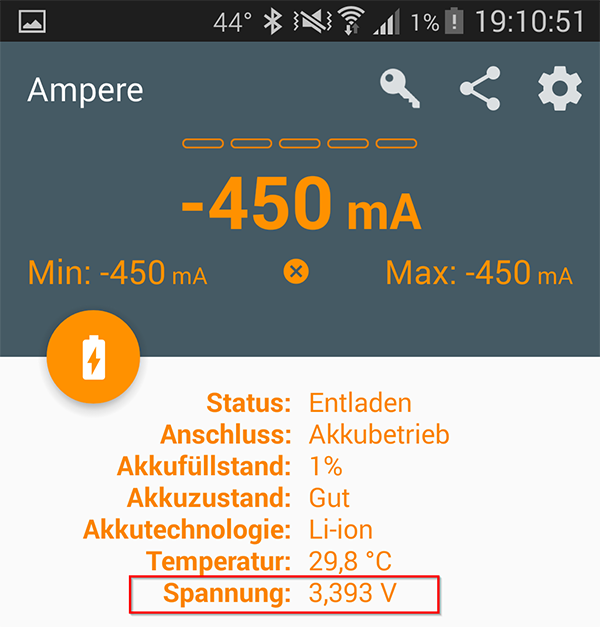
But: I just discovered that the galaxy s5's battery is a 3.85V li-ion battery with a charging voltage of 4.4V instead of 4.2V..
But even then, the 3.8V S4 battery which I'm going to use for my sensors will approximately reach less than 3.3V not before the battery is under 5% charging state I think.
-
I just added revision 0.3 to the first post:
@HenryWhite said:
Rev 0.3: swapped footprints of DHT22 and prototyping area to prevent false temp measurements when charging the battery; connected TP4056 OUT to arduino's RAW instead of VCC_IN (so the internal voltage regulator is used)
sensorboard_v0.3.sch
sensorboard_v0.3.brd
-
Thanks for Rev 03. Another optimization would be to turn the DHT22 180 degrees. Then the open front would face outside. Better for air circulation if put into a case with only a small open slot for the DHT.
-
This post is deleted!
-
Here it is: Revision 1.0
Changes:
- Now with additional relay, properly connected using 2N2222A transistor, flyback diode, 1kΩ resistor and terminal block for easy attaching of "switchable things" to the relay
- proper alignment of DHT22
Schematics (Rev 1.0)

Board view (Rev 1.0)

3D board view (Rev 1.0)

Build files
Eagle files: 0_1453762986505_Sensorboard_v1.0.zip
Gerber files: 0_1453763061782_Sensorboard_v1.0_Gerber.zip
-
I just received my ordered PCBs (Revision 0.1) from Elecrow. The PCBs are very well made for that low price! (I got 14PCBs for 14$)
It fits nicely in a 75x75mm electric box (not the prettiest housing, but very cheap and easily processable for drilling holes for the connections; plus you can paint it to make it more beautiful
 )
)Since it is revision 0.1, I had to cut one pcb trace (V+ from POWER to Arduino's V_IN) and connect V+ from POWER manually with Arduino's RAW input.
Soldering directly to the battery went better than I thought!
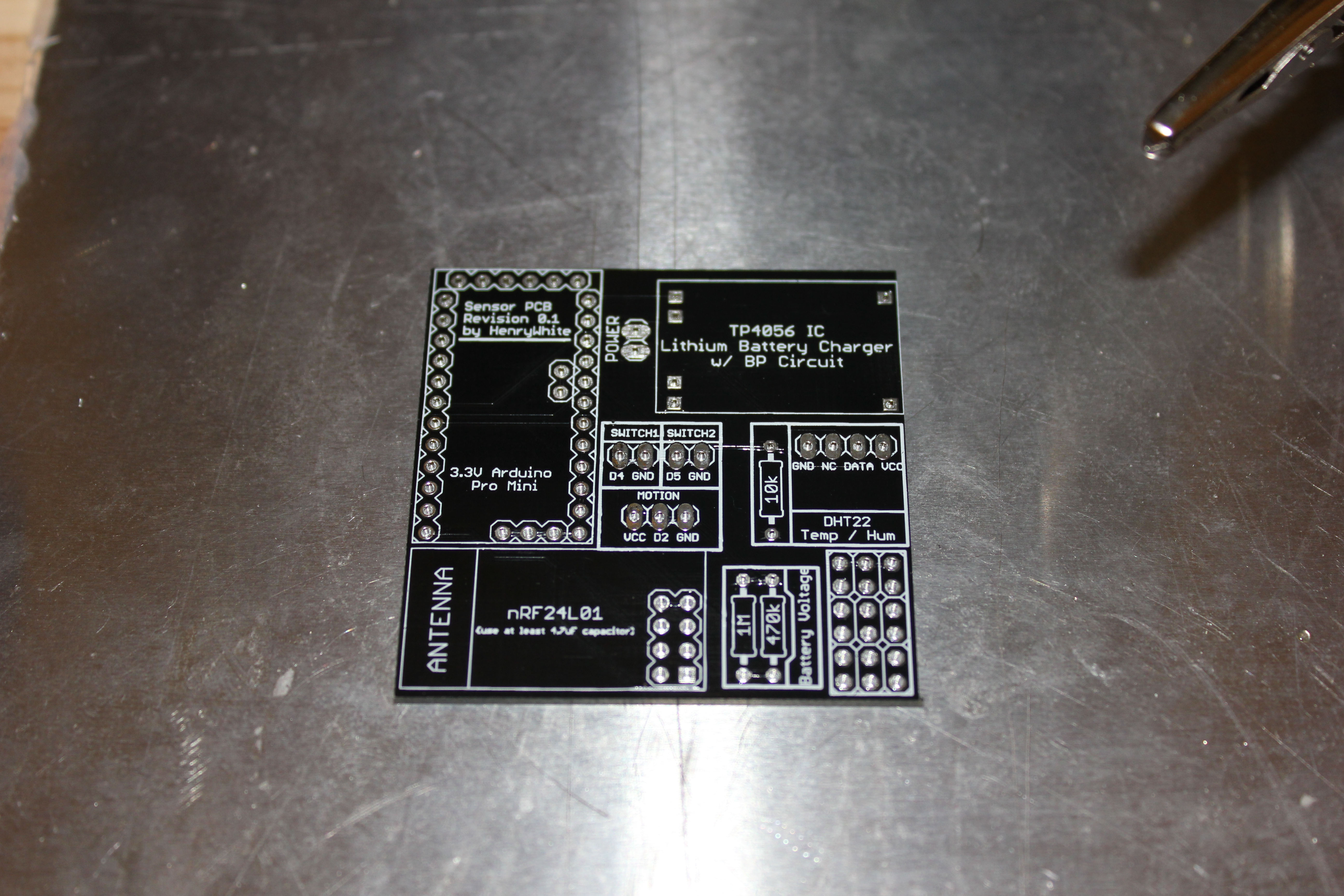
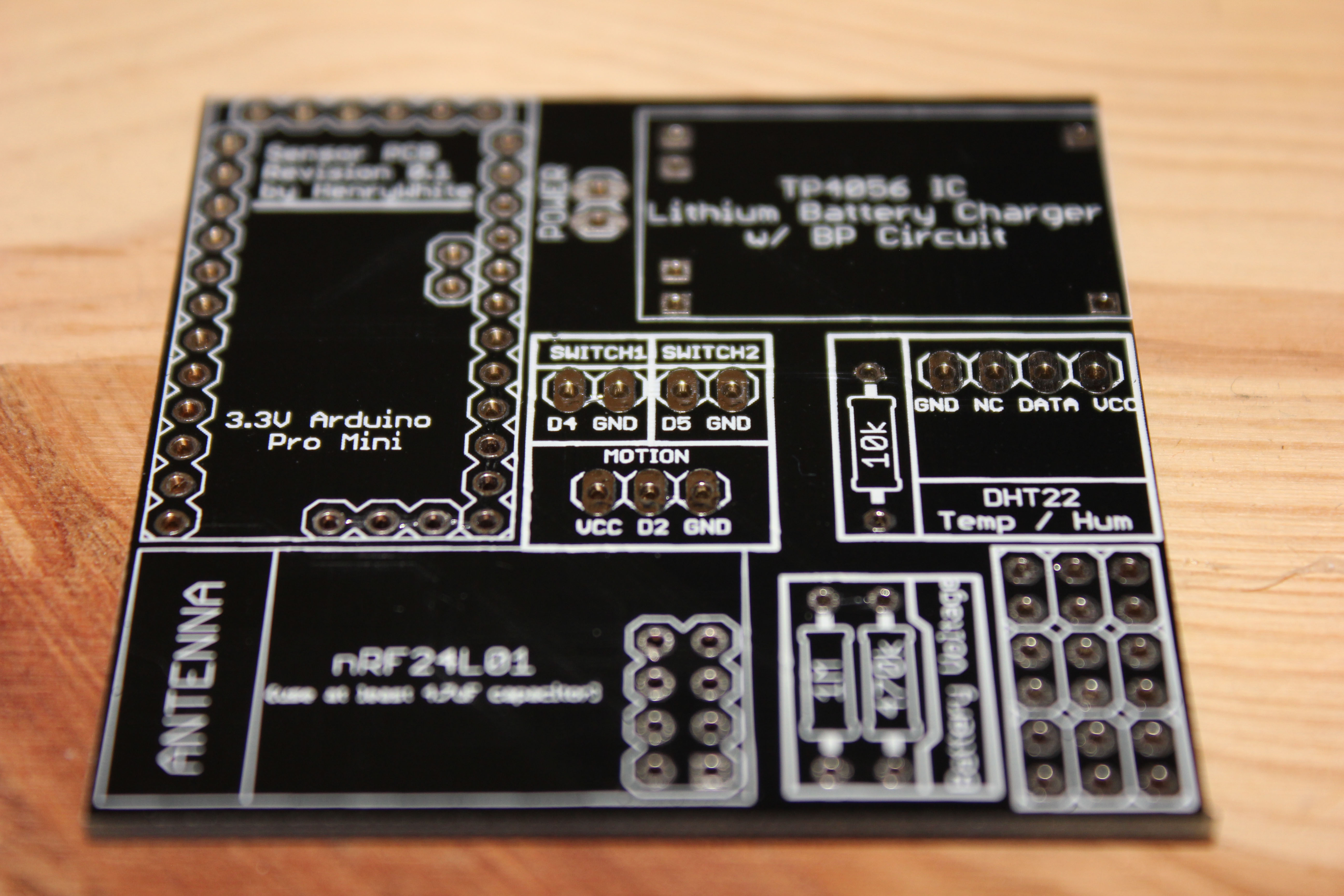
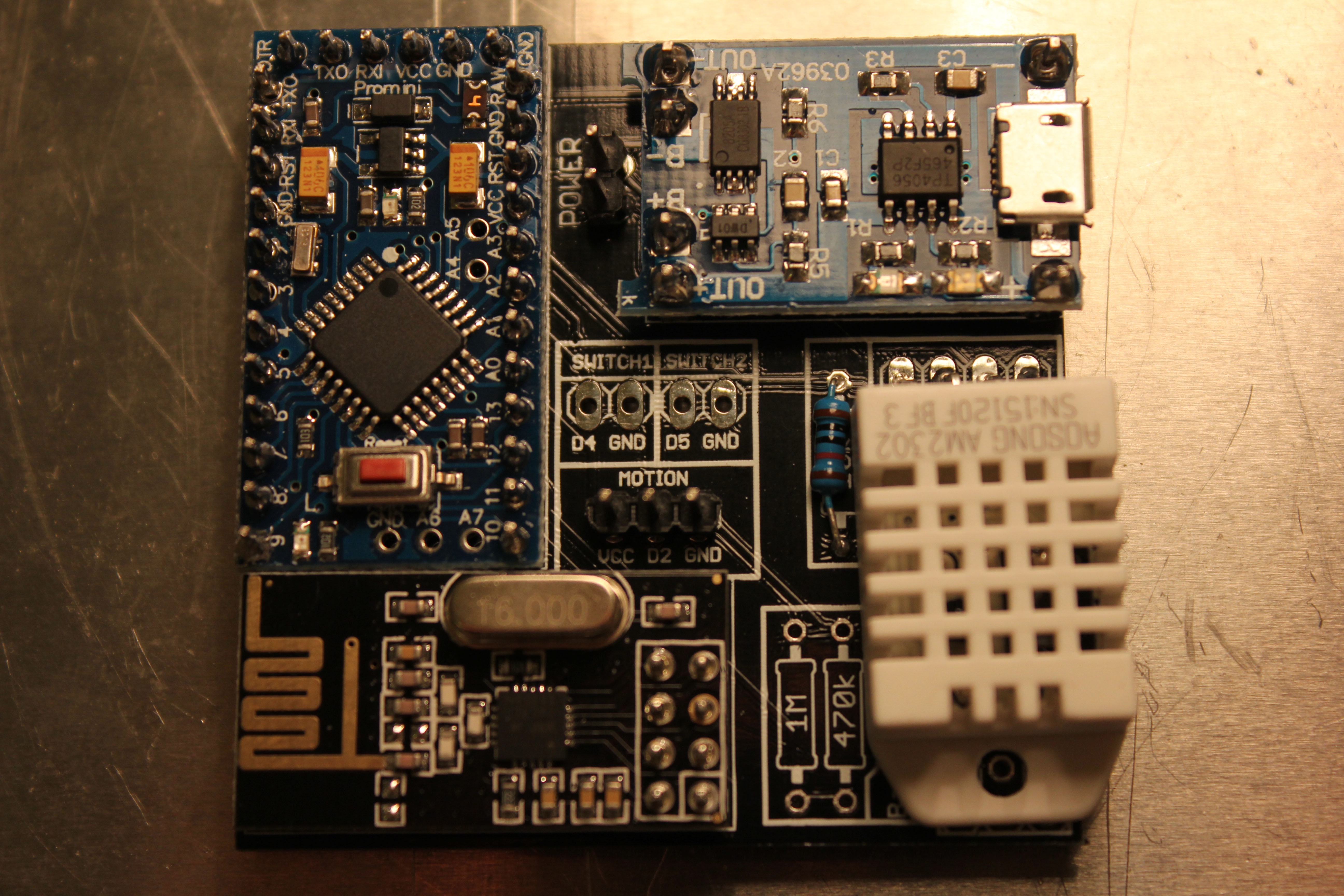
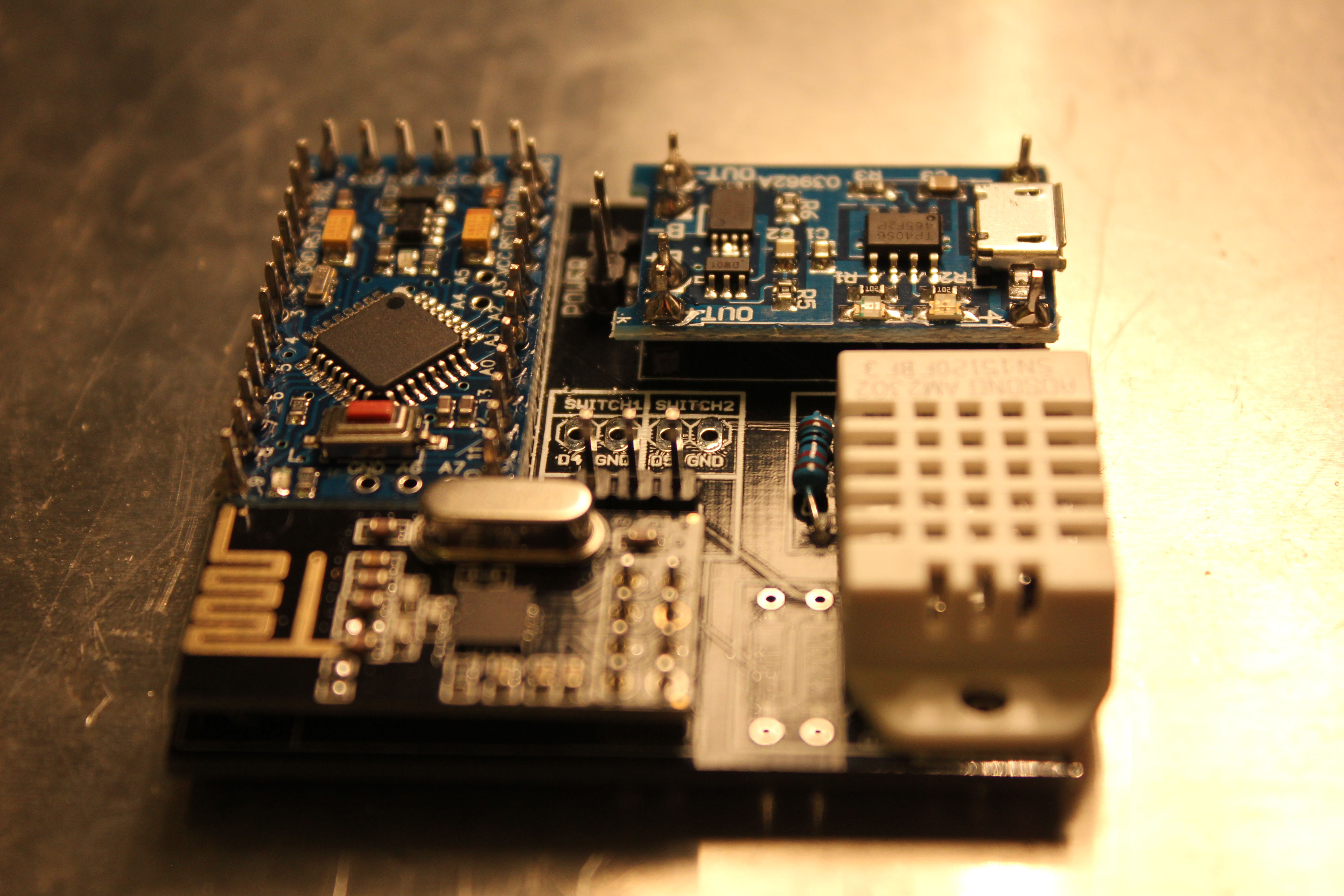
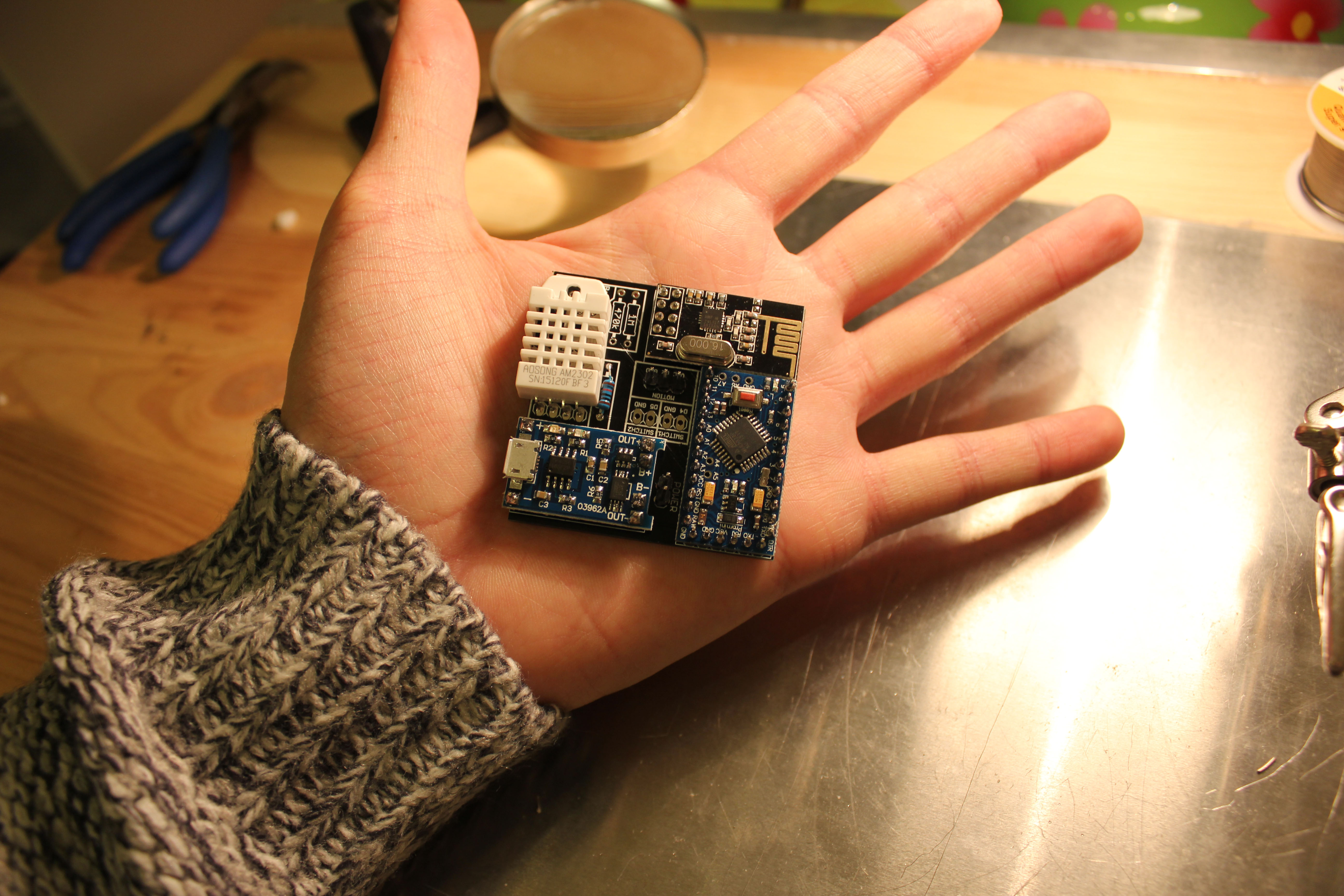
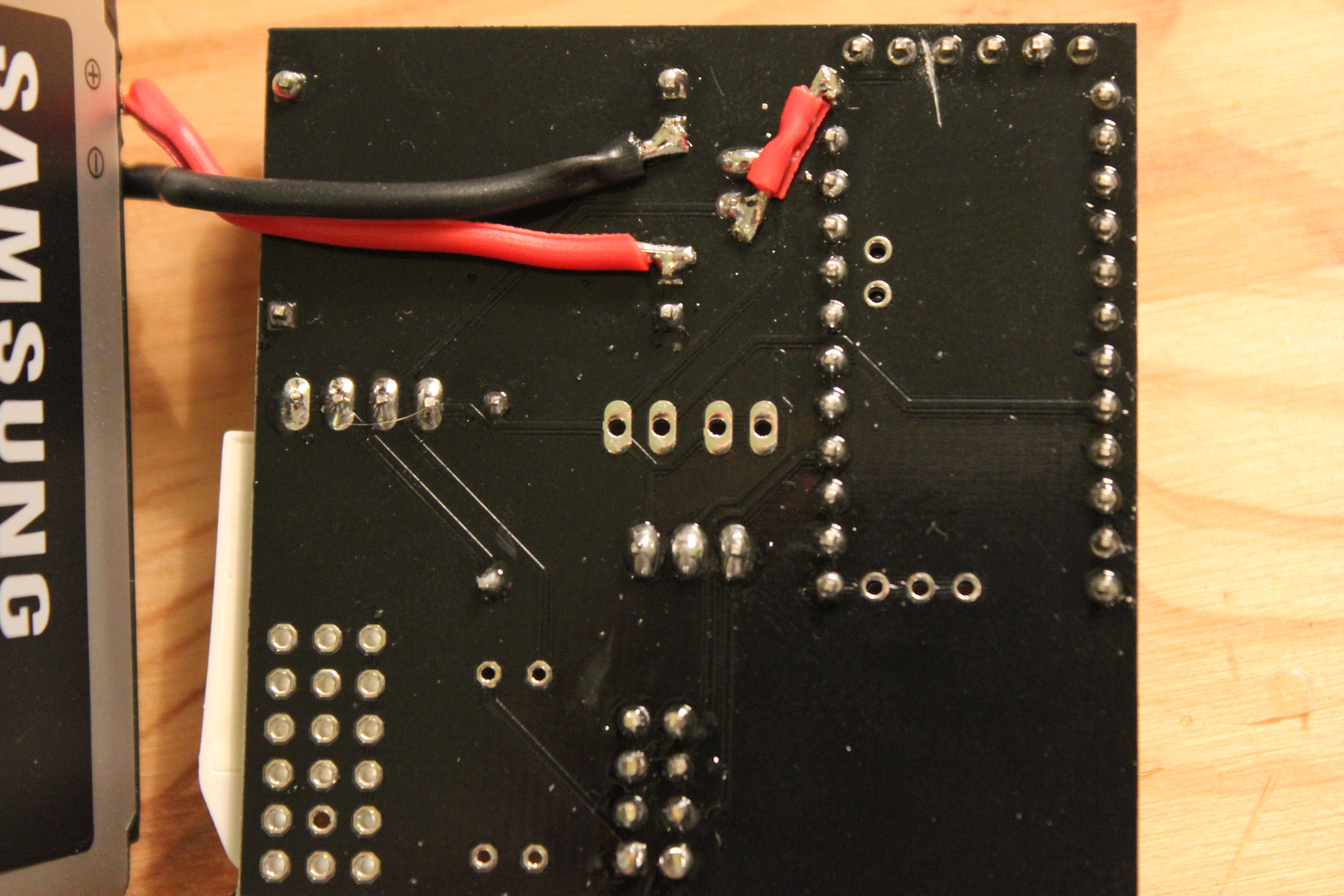
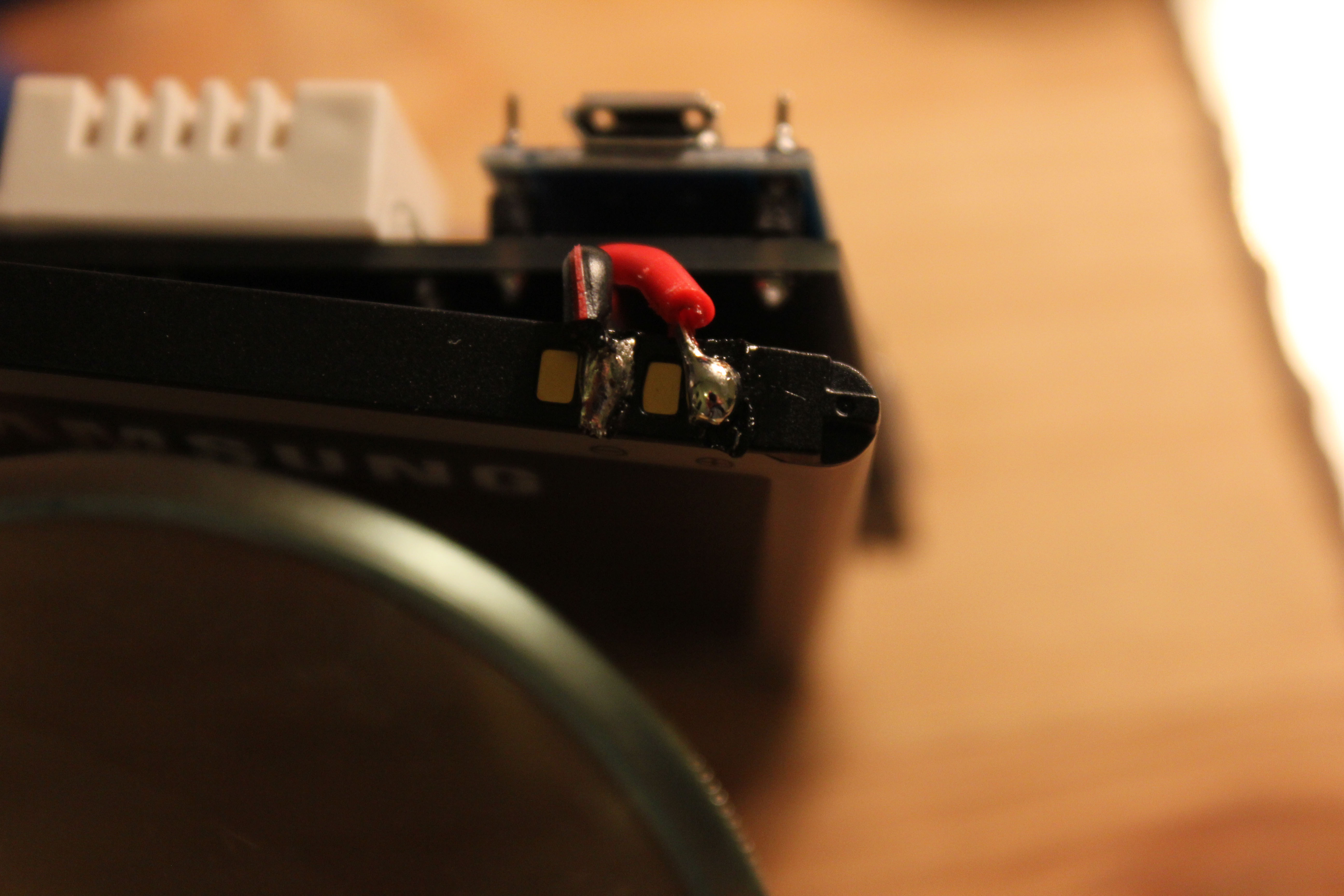
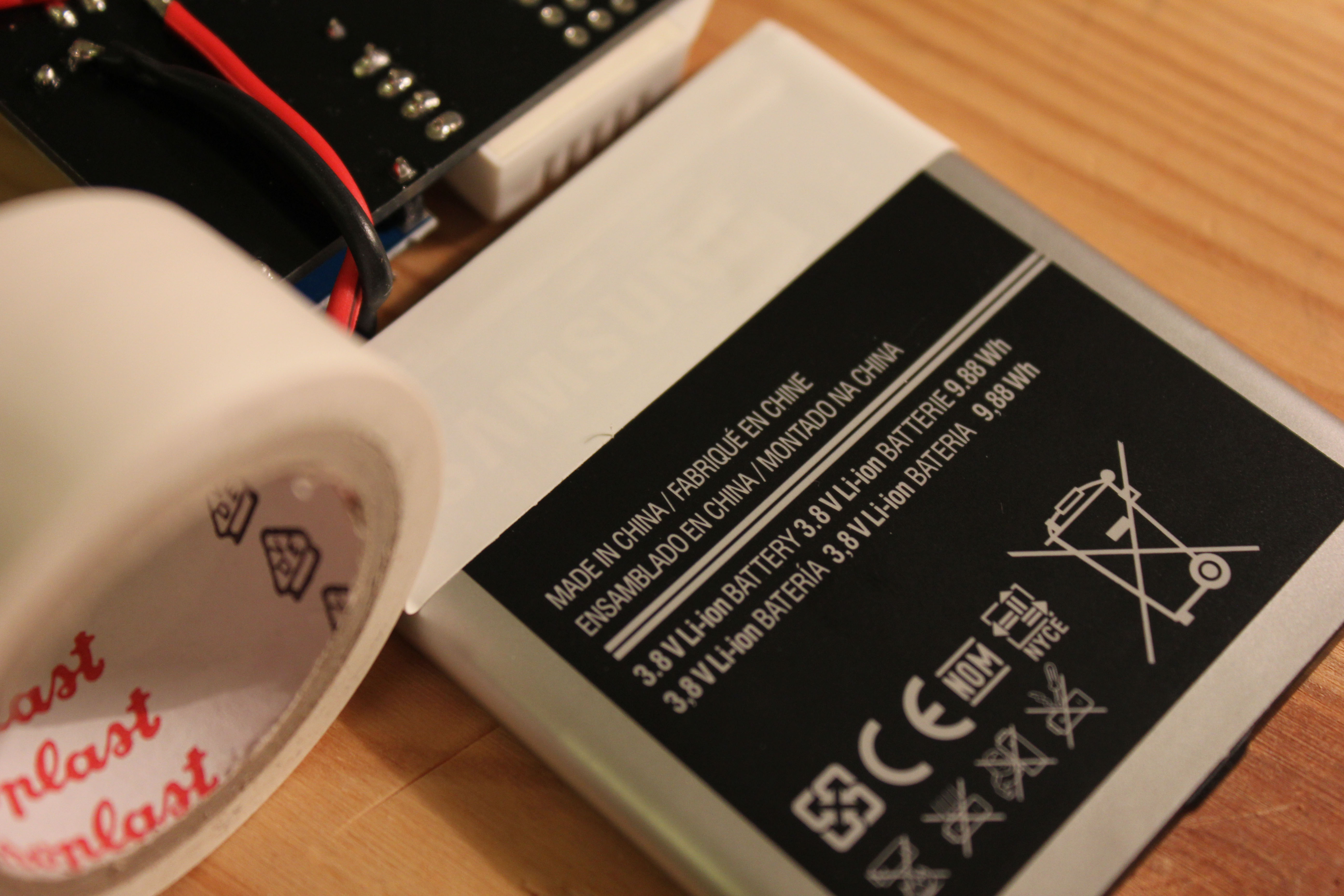
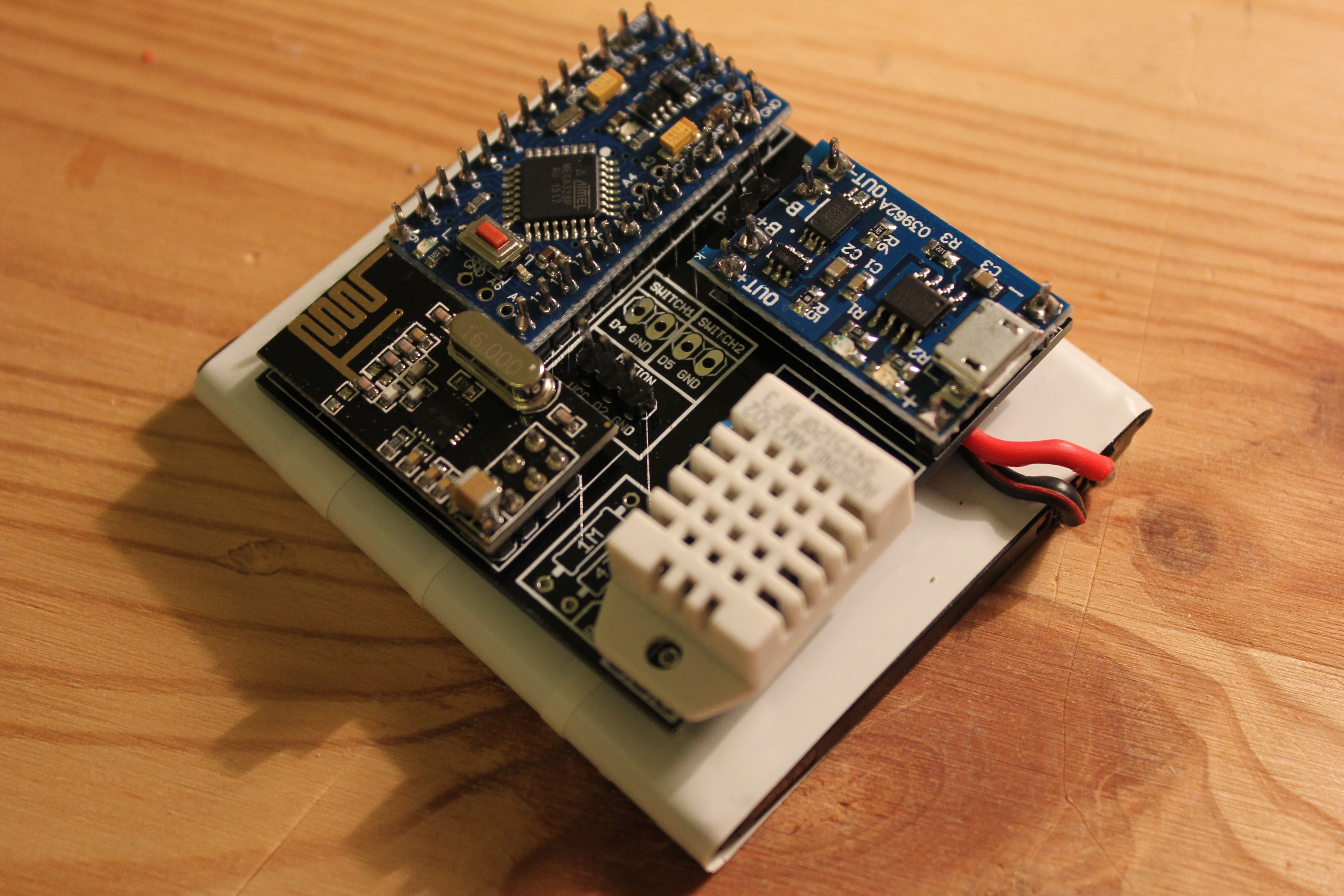
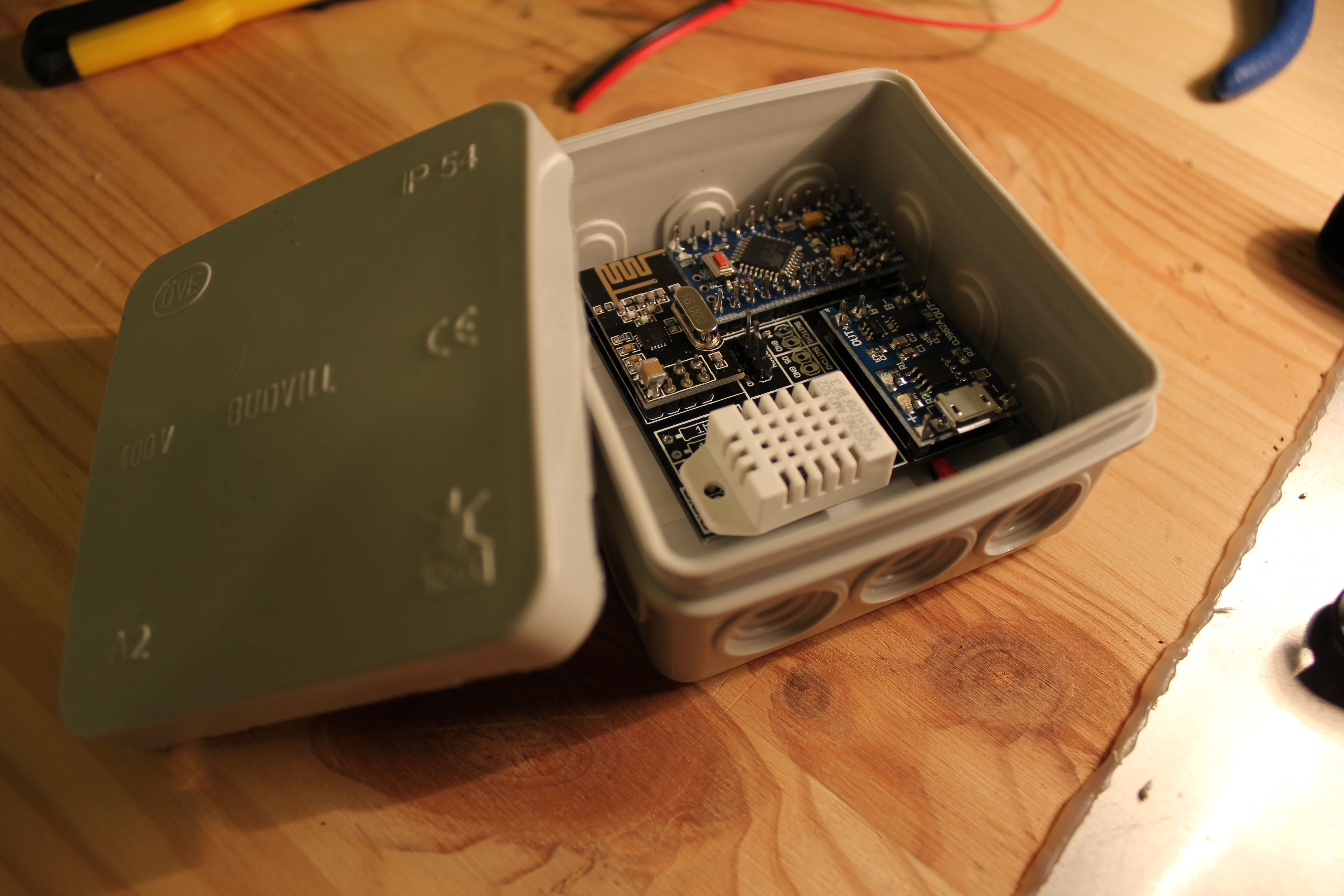

-
Nice, but I think R3 =330k would give you a better battery voltage monitoring divider ratio (Vmax 4.43V). Maybe a little higher total resistance would limit current loss though (even 10M+3M would work).
Maybe something useful here.
-
@m26872 said:
Nice, but I think R3 =330k would give you a better battery voltage monitoring divider ratio (Vmax 4.43V). Maybe a little higher total resistance would limit current loss though (even 10M+3M would work).
Maybe something useful here.Good point!
 Didn't thought about that.
Didn't thought about that.
-
@HenryWhite Did you make any estimates how long your node is running on the fully charged battery?
-
@alexsh1 said:
@HenryWhite Did you make any estimates how long your node is running on the fully charged battery?
I'm just testing it

The Version without relay (Rev. 0.3) should be good for at least two months, assuming you want to read temp/humidity every 60 seconds and you have a 2600mAh (smartphone) battery.
I think you can improve the battery life much further, for example with the following:- a better sketch, e.g. bigger sleep time
- removing the power LED on the arduino
- higher battery capacity
The DHT22 is also drawing much current, i think i will replace it in a next version with a Si7021.
PS: The version with relay could never run very long, because you need to keep the node awake in order to send a command to switch the relay. But even if you use the relay version, you could just attach a bigger battery.
-
@HenryWhite Thanks - I was gonna make this suggestion about the DHT22:
- you do not need temp/hum every 60 sec. 5 -10 mins should be enough
- Power LED has a negligible consumption if you have DHT22 onboard.
- I have Si7021 (powered by two batteries) and DHT22 (powered from 240V via AC/DC adapter). Si7021 is more accurate and less power hungry. My suggestion would be Si7021 or BMP280 as they are working the best with batteries.
Just out of curiosity, what do you do when the battery is flat? Take out the node and charge it? Or charging is automated?
-
@alexsh1 said:
Just out of curiosity, what do you do when the battery is flat? Take out the node and charge it? Or charging is automated?
You don't have to take anything apart. Just plug in a micro usb loading cable in the Tp4056 and the battery will be charged. Plus, you never need to shutdown the node, charging works simultaneously.
-
A little update in terms of battery lifetime: all nodes are still running, I think they will last at least for 10 months before you have to recharge them.
-
I've been looking for some time for similar module/board,
(was too lazy to make it myself) and somehow i never found this board.
If I understood you are now on half the battery (after a six months) ?Did you had any tests with the Relay version on battery power?
I guess it will consume quite some power if it needs to keep relay on from the battery?
If it relay doesn't consume a lot of power then it could be very very useful to have it there (or if it is switched for short period of time and not that often)Project looks very good, it has all it needs for generic module, thank you for making it.
-
@dakipro said:
I've been looking for some time for similar module/board,
(was too lazy to make it myself) and somehow i never found this board.
If I understood you are now on half the battery (after a six months) ?Did you had any tests with the Relay version on battery power?
I guess it will consume quite some power if it needs to keep relay on from the battery?
If it relay doesn't consume a lot of power then it could be very very useful to have it there (or if it is switched for short period of time and not that often)Project looks very good, it has all it needs for generic module, thank you for making it.
Yes, i expect the battery to last ~12 months with one motion sensor + temp/hum sensor installed.
When you want to use the relay, the board normally consumes a lot more power and the battery would not even last 1 month I think, because your board has to be active all the time to receive commands for the relay.If you do not insist on instant relay switching, you could implement the SmartSleep() functionality of mysensors. With this the battery should last way longer, maybe even as long as without relay.
By the way, I got myself a 3D printer and designed a casing for my usecase (motion sensor -- but the case should fit a variety of other components too):
![0_1470836685263_PHOTO_20160810_154021[1].jpg](/uploads/files/1470836690189-photo_20160810_154021-1.jpg)
![0_1470836715515_PHOTO_20160810_154056[1].jpg](/uploads/files/1470836720266-photo_20160810_154056-1.jpg)

-
Makes sense. I am just comparing different editions, it appeared to me that the relay board could be a completelly separate project/pcb, as it would not work quite well on the rechargeable battery, and has quite a different purpose/audience I guess.
Rev 0.3 would then be trully "rechargeable" battery sensor (as in the title), and rev 1.0 would be completelly different, or does it contain same pins as 0.3 (pluss relay which can simply be ignored?).I would use it for motion, temp+hum, door switch and light/lux meter, is it then safe to order rev 1.0 for such a sensor?
And to order it, i usually/only need the .brd and sch files right?
p.s. custom housing looks very slick

-
@dakipro said:
Rev 0.3 would then be trully "rechargeable" battery sensor (as in the title), and rev 1.0 would be completelly different, or does it contain same pins as 0.3 (pluss relay which can simply be ignored?).
Rev 1.0 has nearly the same pins, except that you can only connect one switch (Rev 0.3: two switches) - but yes, you can simply ignore the relay, diode and transistor if you don't want to use a relay.
Nonetheless, if you are sure that you will never use the board with a relay, I suggest that you go with Rev. 0.3.And to order it, i usually/only need the .brd and sch files right?
It depends on the pcb manufacturer, but most of the time you will need the gerber files (which can be generated with the .sch file through the CAM-processor with the .cam file (which the specific board house provides).
PS: I ordered my boards from elecrow.
-
Thanks, I was ordering from oshpark before, but I see that elecrow has some nice prices as well.
I noticed that you have _gerber.zip for 1.0, if you by any chance find _gerber.zip for 0.3 I would appreciate if you upload it to the thread
(no, i am not lazy to convert them with eagle, but still not confortable and afreaid that I might select some wrong option )
)
-
@dakipro here you go:
0_1470866547655_Gerber_rev0.3.zip
Be aware that this are the gerber files for the pcb service from elecrow. Other pcb services may have other specifications!
-
Hi HenryWhite,
Great job, very nice.
I have some questions:
- Why do you sent input voltage to A0? is it for voltage supervision?
- Is it possible to have your sketch file?
Thanks for your sharing,
TouFou
-
@toufou said:
Hi HenryWhite,
Great job, very nice.
I have some questions:
- Why do you sent input voltage to A0? is it for voltage supervision?
- Is it possible to have your sketch file?
Thanks for your sharing,
TouFouHi, yes it's for measuring the battery level.
You can find the schematics and all the other files in my first post.
-
Hi,
Thanks for your reply.
In the first post, i see schematics, brd and gerber file, but i don't see .ino file to flash arduino pro mini.....
-
@toufou said:
Hi,
Thanks for your reply.
In the first post, i see schematics, brd and gerber file, but i don't see .ino file to flash arduino pro mini.....You can adapt the example sketches MySensors offers, it shouldn't be hard. Also the sketch will depend on what you plan to use the board for. (Motion, Switch, Temperature,...)
-
Ok!
I thought you had specific because your sensor is about 10month with arduino regulator! excellent.
Another question:
You use a motion sensor as i want. You make a reference to a hack to use it with 3.3V instead of 5V. Have you a link to see that?Thanks
-
@toufou said:
You use a motion sensor as i want. You make a reference to a hack to use it with 3.3V instead of 5V. Have you a link to see that?
Yes, here's a picture (the only thing you have to do is solder vcc to the HIGH-pad of your motion sensor):
